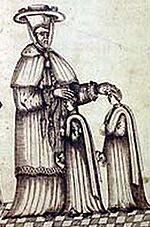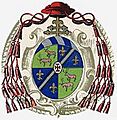Gaspar Cervantes de Gaeta facts for kids
Gaspar Cervantes de Gaeta (born in Trujillo around 1511 – died in Tarragona on October 17, 1575) was an important Spanish cardinal in the 1500s. He was a relative of the famous Spanish writer Miguel de Cervantes.
Quick facts for kids Gaspar Cervantes de Gaeta |
|
|---|---|
| Archbishop of Tarragona, Spain | |
 |
|
| Church | Catholic Church |
| Appointed | 1568 |
| Reign ended | 17 October 1575 |
| Predecessor | Bartolomé Sebastián Valero de Arroítia |
| Successor | Antonio Agustín y Albanell |
| Other posts | Cardinal-Priest of S. Vitale (1570) Cardinal-Priest of S. Martino in Montibus (1570–1572) Cardinal-Priest of S. Balbina (1572–1575) |
| Orders | |
| Consecration | 1561 |
| Created Cardinal | 10 March 1570 |
| Personal details | |
| Birth name | Gaspar de Gaeta Alonso |
| Born | ca. 1511 Trujillo, Spain |
| Died | 17 October 1575 (aged 64) Tarragona, Spain |
| Buried | Tarragona Cathedral |
| Nationality | Spanish |
| Denomination | Catholicism |
| Residence | Archbishop's Palace of Tarragona |
| Parents | Francisco de Gaeta María Alonso de Cervantes |
| Previous post | Bishop of Messina, Italy (1561–1564) Bishop of Salerno, Italy (1564–1568) |
| Alma mater | University of Salamanca University of Paris |
| Coat of arms |  |
| Styles of Gaspar Cervantes de Gaeta |
|
|---|---|
 |
|
| Reference style | His Eminence |
| Spoken style | Your Eminence |
| Informal style | Cardinal |
Contents
Early Life and Education
Gaspar Cervantes de Gaeta was born in Trujillo, Spain. His parents were Francisco de Gaeta and María Alonso de Cervantes. He went to college at the University of Salamanca in Spain. He also studied at the University of Paris in France. After his studies, he became an important legal advisor for the church in the Kingdom of Aragon.
Early Church Career
Cervantes held several important positions in the church. He was a leading official in the diocese of León. He also served as a church official in Seville, Zaragoza, and Naples.
In 1561, he became the archbishop of Messina, Italy. Later, in 1566, he was made the archbishop of Salerno, Italy. While there, he organized several important church meetings.
Cervantes also took part in the Council of Trent. This was a very important meeting for the Catholic Church. He was known for being a great speaker and very wise. Because of this, Pope Pius IV trusted him a lot. The Pope gave him many important church tasks.
In 1568, he was chosen to be the archbishop of Tarragona, Spain. However, he did not arrive in Tarragona until 1572.
Archbishop of Tarragona and Cardinal
While he was the archbishop of Tarragona, Pope Pius V made him a cardinal. This happened on May 17, 1570. As a cardinal, he was given different "titular churches" in Rome. These were churches he was connected to. He was first linked to Saint Vitale, then Saint Martino in Montibus, and finally Santa Balbina.
Because of these duties, he spent four years in Italy after being named archbishop of Tarragona. During his time in Rome, he also served as the Pope's special representative for the kingdoms of Spain.
Cervantes returned to Tarragona in May 1572. That same year, he started the University of Tarragona. He gave a lot of money, about twenty thousand Catalan pounds, to help start this university.
In 1573, he allowed the village of Almoster to have its own baptismal fonts. This meant people from Almoster did not have to travel to Reus for baptisms.
In 1574, Cervantes helped close down the monastery of Escornalbou. The money from this was used to create the Seminary of Tarragona in 1575. This seminary was one of the first of its kind in Spain. In 1577, it joined with the University of Tarragona.
He also started a training center for Jesuit monks in 1575. He created a special church position and a home for Jesuit monks. He also helped set up a place for people in need and supported an orphanage.
Cervantes was also concerned about the safety of Tarragona. He thought the inner part of the harbor could be attacked easily. So, he decided to make the city's defenses stronger. He added a new part, called a bastion, to the ancient Roman walls. This new part was named after him.
From 1572 to 1574, he held an important church meeting in Tarragona. His helper bishop was Joan Terès i Borrull.
In 1574, Tarragona faced a severe drought. Cervantes tried to bring water to the city by redirecting a water channel from Puigdelfí. Sadly, he died on October 17, 1575, before he could finish this project.
In 1577, his body was moved to a special tomb in the Tarragona Cathedral.
Legacy
Gaspar Cervantes de Gaeta left a lasting impact. In his hometown of Trujillo, he ordered the building of an altar in Saint Martin’s Church. His mother's remains were placed there. This altar is still known as the "Altar of Gaeta."
He also gave sixteen beautiful tapestries from the 1500s to the Tarragona Cathedral. These tapestries were made in Brussels.
In his will, Cervantes made sure the University of Tarragona had clear rules for how it should be run. This was very important. It helped prevent the university from being closed down years later by King Philip V of Spain.
Cervantes also wrote books. One of his works was titled Instruccions, y advertiments molt útils necessaris per les persones ecclesiàstiques. It was first published in Italian. When he moved to Tarragona, he had it translated into Catalan. He also published Constituzioni Sinodali della Chiesa di Salerno in Rome in 1568.
The famous writer Lope de Vega wrote a special poem about Cervantes.
Today, a street in Tarragona is named Cardinal Cervantes street in his honor.
Images for kids
See also
 In Spanish: Gaspar Cervantes de Gaeta para niños
In Spanish: Gaspar Cervantes de Gaeta para niños


